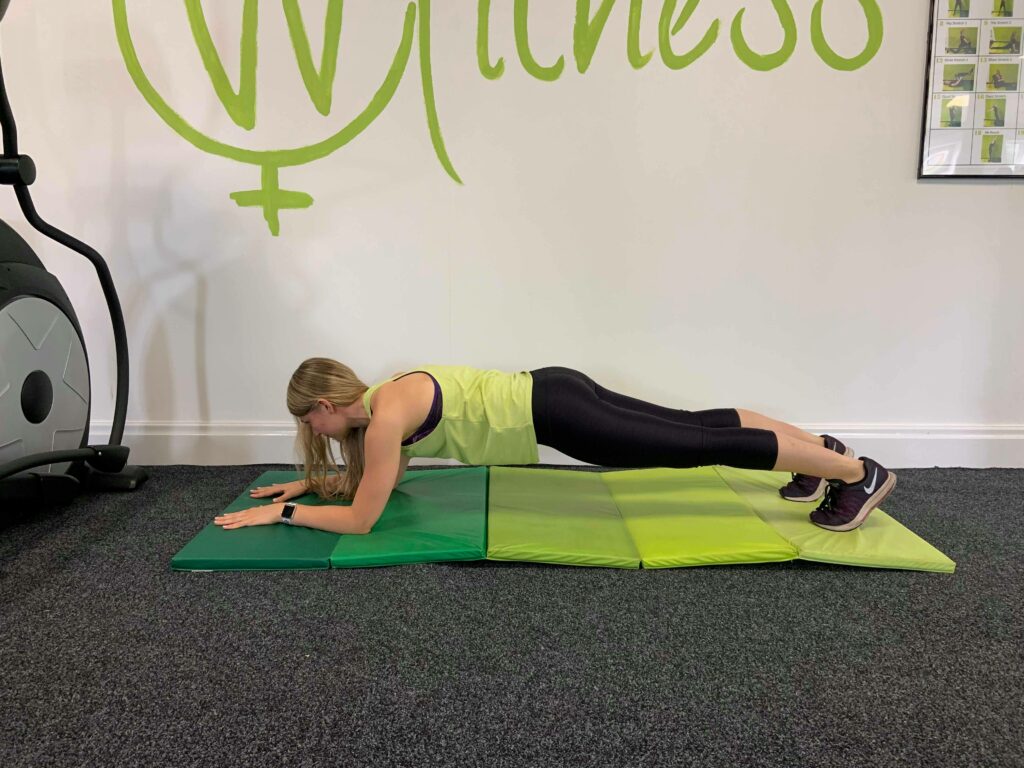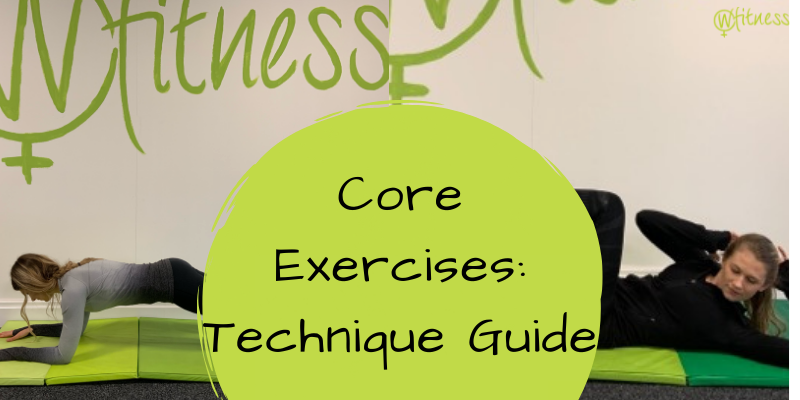The core is the powerhouse muscle. Having a strong core makes it easier to do everyday activities and keeps you strong well into old age. Having a strong core has been shown to lower the risk of back pain and injuries. It is connected to both the upper and lower body and plays a huge part in any activity, whether that’s day to day or sports.
We all want a flat stomach and great abs, more strength and tone but it takes a lot of work. There is no quick fix, but you want to make sure that the exercises you are doing are done with the correct technique to get you the best results.
Let’s look at some core exercises, how to do them correctly, and common mistakes that you might be making.
Ab Crunch
Ab crunches are an intense exercise working the abdominal muscles, strengthening the core, the oblique muscles, and the lower back. They can help to improve posture and increase mobility and flexibility.
How to do an ab crunch:
- Lie on your back with your legs bent and your feet on the floor, hip width apart.
- Place your arms either side of your head with your elbows bent, on your thighs or keep them straight, at the side of your body and a few inches off the floor.
- Squeeze your abs tightly, breathe out and slowly lift your upper body (head and shoulders).
- Pause at the top of the movement for a couple of seconds and slowly lower back to the floor, still using your abs.
- Keep your head and neck relaxed throughout.
Common mistakes are:
- Pulling on your neck. This has to be the most common mistake when doing an ab crunch. Pulling on your neck doesn’t make the ab crunch any easier and can, in fact, pull a muscle in your neck and cause neck pain. Your abs should be doing all the work in this exercise and not your neck, so if you find that you do pull on your neck, try one of the other positions for your arms, either on your thighs or keep them straight and at the side of your body, a little off the floor.
- Pulling your elbows forward. This is another mistake that doesn’t make this exercise any easier. Your elbows will not help you to perform the perfect ab crunch! Keep those elbows out to the side.
- Looking up. If you look up to the ceiling and stick your chin out, you will end up over working your neck and possibly causing soreness or pain after your workout. Keep your head and neck neutral – imagine that you have a ball between your chin and chest and keep it there throughout the movement.
- Not crunching up high enough. Unfortunately, just lifting your head and neck off the floor isn’t enough to work your ab muscles. You need to be lifting your shoulders off the floor and curling up to the bottom of your shoulder blades.
- Crunching too quickly. Using momentum and speed to lift yourself off the floor is not giving your abs the best workout. Crunching slowly and really squeezing the ab muscles is the best way to tone them. As you get better at crunches, try moving more slowly to control the movement both when lifting off the floor and also when lowering back down. It’s much better to do 10-15 crunches performed slowly and correctly, with good technique than it is to try to do 100-150 quickly and with bad technique. It’s not about how many you do, but the fact that you do them properly to make sure that you are working the right muscles.
Bicycle Crunches

Bicycle crunches work the ab muscles along with the obliques, hips, hamstrings and quads. They are especially good for working the deep ab muscles, improving co-ordination and giving you a stronger core.
How to do a bicycle crunch:
- Lie on the floor with your legs bent, feet on the floor hip width apart and your lower back pressed into the floor.
- Keep your hands by the side of your head with your elbows bent.
- Squeeze your core muscles tightly and raise your legs off the floor.
- Keep your shoulder blades back and, using a cycling motion, bring one knee towards your chest whilst straightening the other leg, making sure to keep both legs higher than the hips. At the same time, twist your torso so that your elbow can touch the opposite knee. Repeat on the other side and keep the cycling motion going.
Common mistakes are:
- Pulling on your neck. This will cause strain and neck soreness. Make sure that your torso is doing the work. If you can’t reach your elbow to your knee, then just rotate, and reach as far as you can.
- Twisting the hips. It is only your torso that should be twisting. Make sure to keep your lower back pressed into the floor and your hips stable. Your hips should not be twisting as you move your legs forwards and backwards.
Plank

The plank is a full body exercise working not only the abdominals, but the obliques and back muscles as well as the shoulders. It is good for improving strength, balance, and co-ordination.
How to do a plank:
- Lie on the floor on your front, with your legs straight and resting on your forearms, keeping your elbows below your shoulders.
- Squeeze your core muscles tightly and slowly lift up onto your toes. Your head, hips and knees should be in a straight line.
- Keeping your core muscles tightly squeezed, hold this position for between 10 – 30 seconds and slowly build up the time.
Common mistakes are:
- Forgetting to breathe. Don’t hold your breath whilst doing a plank as this can cause other muscles, such as the back or neck, to take over, causing strain. Concentrate on your breathing, being conscious of the inhale and exhale (pulling your belly button in as you exhale), and keeping it controlled.
- Not keeping your body in a straight line. Are your hips dipping below your shoulders or is your bum sticking up in the air? You need to engage your core muscles and squeeze your glutes. Keep your hips stable and at the same level as your shoulders and pull your elbows in towards your body.
- Dropping your shoulders. This causes extra stress on the shoulders and makes the rest of the body less stable. Try to push the floor away from you and open the shoulder blades, as this makes you more stable and creates more pressure and force throughout the body.
- Bending your knees. This causes you to be less stable throughout the whole body, often leading to your back dipping. Try to push your heels away from you to keep your body in a nice straight line, creating a strong plank.
Reverse Crunch and leg lower
This is an intense exercise that targets your ab muscles, reaching the deep ab muscles.
How to do a reverse crunch:
- Lie on the floor on your back, with your legs straight and your arms by your side, pressing your arms and palms into the floor to help keep you stable.
- Relax your shoulders and neck and look at the ceiling.
- Slowly raise your legs until they are at 90°. (You can bend your knees to crunch if you need to, but the straighter your legs are, the more you will be working your abs).
- Breathe out, squeeze your abs and glutes and push your heels up towards the ceiling to lift your lower back and bum off the floor briefly.
- Slowly roll back down through the spine and lower your legs to the floor, controlling the movement and repeat.
Common mistakes are:
- Moving too quickly. Make sure you are controlling the movement, keeping everything squeezed and tight – don’t rock, swing your legs, or use momentum to lift your hips off the floor.
- Lifting too high off the floor. This is just a small movement so only lift an inch or two off the floor.
Bird Dog Crunch
The bird dog works the core muscles, hips, glutes and the erector spinae muscles (a series of muscles that straighten and twist the back). This is a great exercise for improving stability and mobility, alleviating lower back pain and improving posture.
How to do the bird dog:
- Start on your hands and knees on the floor, with knees hip width apart and hands shoulder width apart (with enough space around you to extend your arms and legs)
- Squeeze your core and glute muscles tightly and slowly extend one leg and the opposite arm until they are straight. Keep your hips still and stable and your back straight.
- Hold for a couple of seconds and then slowly return to the start position on your hands and knees, keeping your abs tightly squeezed.
- Repeat on the other side.
Common mistakes are:
- Not engaging your core and glutes. This is needed to strengthen the spine and protect the lower back.
- Twisting your hips. This will cause back problems and won’t be working the correct muscles. Make sure to keep the hips stable.
- Letting your back and stomach sink down as you extend the leg. This makes the chest lift and the hips drop. Only lift your leg as high as you can without letting your back sag and concentrate on squeezing the glute muscle. Keep your torso and back straight, and your head and spine in a neutral position.
- Letting your chest drop. Keep your arms strong to hold you in the right position.
These exercises are great core exercises if they are performed with the correct technique, not only to get the best out of your workout, but also to prevent injury.
10 Minute Workout
Why not take a look at our 10 minute core workout here to strengthen your core!
Get in touch with us at W Fitness to see how we can help you with your health and fitness journey, and make it fun along the way 😊
Much Love
Caroline & Hannah xx
